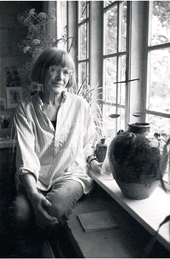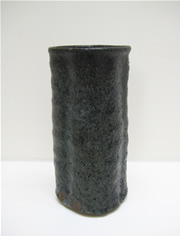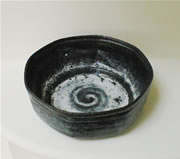GUTTE ERIKSEN (1918-2008)

Gutte Eriksen was born in 1918 in Rødby on the island of Lolland in Denmark. She studied at the Kunsthåndvaerkskolen in Copenhagen from 1936 to 1939. In 1941 she set up a studio with two other artists in Hareskov, loving to her own studio in Kastrup the following year. From 1953 she worked in her studio at Karlsminde. In 1948 she spent two months working with Bernard Leach in St Ives, and later that year she worked in France with Pierre Lion and Vassil Ivanoff. She visited Japan to work with potters there in 1970 and again in 1973.
Gutte Eriksen influenced a generation of Danish potters with both her work and teaching. She taught at the Jutland Academy of Fine Arts, Arhus, in 1968-71, 1973-4 and 1976-8. Her public commissions include fountains in Østre Landsret and Holstebro. In 1972 she won the Gold Medal in Faenza and in 1985 she was awarded the Thorvald Bindesbøll Medal of the Danish Academy of Fine Arts. In 2000 she was given The Prince Eugen Medal, awarded by the Swedish Royal Family for outstanding artistic achievement. She was honoured with a major retrospective at the Vejen Kunstmuseum in 2001. Gutte Eriksen died in 2008.
Above: Gutte Eriksen, 1995
Read more...
"Can pots have a nationality? It is often claimed that music can, that composers as different as, say, Elgar, Delius and Vaughan Williams share a distinctive English quality, that Beethoven and Brahms are unmistakably Germanic. Can you say the same sort of thing about potters? Is Gutte Eriksen the Sibelius of ceramics?
The notion is not too far-fetched. After all, potters originally used the clay that could be dug around their workshops and glazed their pots with ash from local trees and minerals crushed from local ores. If any work of art is derived directly from the land, it is surely pottery. It would hardly he surprising if the products of potteries in the same neighbourhood shared many characteristics.
I do not know whether Gutte Eriksen uses local clay or locally derived glazes. Perhaps she doesn’t, for these days both can be supplied commercially from distant sources, easily, reliably and consistently. But more important than materials are the hands and eyes that shape them, and I do know that to me at least Gutte Eriksen’s pots speak of Scandinavia.
She reveals that character with misleadingly simple means. She eschews incising, sgraffito, slips and underglaze painting. Her pots are entirely undecorated except for their glaze (though, my goodness, hers provides a decoration as rich as anyone could wish for). She habitually uses the same clay which fires at high temperatures into a heavy earthenware. Yet I do believe that I would have guessed from their craggy character, from the strength that can be felt in the subtle bulges and dents of their forms that these pots come from a country where physical toughness and vigour are prized, where the natural world can be uncompromising, where there is no place for the weak.
What appealed to me so strongly and indeed, irresistibly when I first saw her pots was the nobility and power of their shapes and the delectable way her subtly varied glazes poured and dripped over their bulges and gathered in creamy pools in their gutters. To my eyes, these magnificent pots were both familiar and yet quite new and as refreshing as a long deep draught of the clearest purest coolest water. Perhaps all that is specifically Scandinavian. My suspicion is that it is also specifically Gutte Eriksen."
Written by David Attenborough for the card to Gutte Eriksen’s exhibition at Galerie Besson in 1995
Exhibitions at Galerie Besson
| Commemorative Mugs for the Millennium | Dec 1999 - Jan 2000 |
| Gutte Eriksen | Jun - Jul 1995 |
| Gutte Eriksen | Mar - Apr 1990 |


